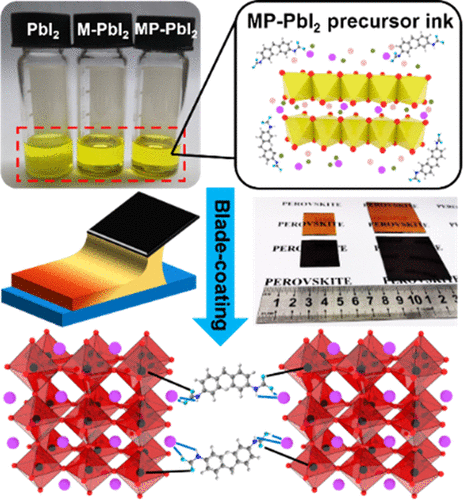当前位置:
X-MOL 学术
›
J. Phys. Chem. C
›
论文详情
Our official English website, www.x-mol.net, welcomes your
feedback! (Note: you will need to create a separate account there.)
Stabilized and Operational PbI2 Precursor Ink for Large-Scale Perovskite Solar Cells via Two-Step Blade-Coating
The Journal of Physical Chemistry C ( IF 3.3 ) Pub Date : 2020-04-01 , DOI: 10.1021/acs.jpcc.0c00908 Zengqi Huang 1, 2 , Xiaotian Hu 1, 2 , Zhi Xing 1, 2 , Xiangchuan Meng 1, 2 , Xiaopeng Duan 1, 2 , Juan Long 1, 2 , Ting Hu 2, 3 , Licheng Tan 1, 2 , Yiwang Chen 1, 2, 4
The Journal of Physical Chemistry C ( IF 3.3 ) Pub Date : 2020-04-01 , DOI: 10.1021/acs.jpcc.0c00908 Zengqi Huang 1, 2 , Xiaotian Hu 1, 2 , Zhi Xing 1, 2 , Xiangchuan Meng 1, 2 , Xiaopeng Duan 1, 2 , Juan Long 1, 2 , Ting Hu 2, 3 , Licheng Tan 1, 2 , Yiwang Chen 1, 2, 4
Affiliation

|
Perovskite solar cells (PVSCs) have made dramatic progress benefiting by various preparation methods in the past few years. Particularly, a two-step deposition technique has been demonstrated as an efficient, low-cost approach to fabricate large-scale PVSCs. However, these large-scale PVSCs are lagging far behind the state-of-the-art spin-coated counterparts because of the unstabilized nature of PbI2 precursor ink and the difficulty in complete conversion to crystallized perovskite films. Here, we demonstrate a stabilized and operational trace methylammonium iodide (MAI)–polyurethane (PU)–lead iodide (PbI2) (MP–PbI2) precursor ink formulation to fabricate large-scale PVSCs via the blade-coating process. The synergetic effects of trace MAI and PU can regulate the rheological properties of PbI2 precursor ink and form an oriented intermediate complex, which are beneficial for constructing compact perovskite films with fewer pinholes and defects. Thus, the MP–PbI2-based PVSCs yield power conversion efficiencies (PCEs) over 19% for a 0.12 cm2 device and 11.07% for a 25 cm2 solar module. Moreover, flexible PVSC with a PCE of 17.30% has been manufactured using this scalable ink formulation and maintaining over 90% of its original PCE after 6000 bending cycles at the radius of 3 mm. This approach opens up a new precursor engineering for achieving large-scale PVSCs via roll-to-roll technology.
中文翻译:

通过两步刀片式涂布用于大型钙钛矿太阳能电池的稳定且可操作的PbI 2前体油墨
过去几年中,受益于各种制备方法,钙钛矿太阳能电池(PVSC)取得了巨大进步。特别地,已经证明了两步沉积技术是制造大规模PVSC的有效,低成本方法。但是,由于PbI 2前体油墨的不稳定特性以及难以完全转化为结晶的钙钛矿薄膜,这些大型PVSC远远落后于最新的旋涂同类产品。在这里,我们展示了稳定且可操作的痕量甲基碘化铵(MAI)-聚氨酯(PU)-碘化铅(PbI 2)(MP-PbI 2)前体油墨配方,以通过刮涂工艺制造大规模的PVSC。痕量MAI和PU的协同作用可以调节PbI 2前体油墨的流变性能,并形成定向的中间配合物,这对于构造具有更少针孔和缺陷的紧凑钙钛矿薄膜是有利的。因此,基于MP–PbI 2的PVSC对于0.12 cm 2的器件产生超过19%的功率转换效率(PCE),而对于25 cm 2的器件产生超过11.07%的功率转换效率(PCE)。太阳能模块。此外,使用这种可扩展的油墨配方可生产出PCE为17.30%的柔性PVSC,并且在3 mm的半径下进行6000次弯曲之后,可保持其原始PCE的90%以上。这种方法为通过卷对卷技术实现大规模PVSC开辟了新的前驱工程。
更新日期:2020-04-01
中文翻译:

通过两步刀片式涂布用于大型钙钛矿太阳能电池的稳定且可操作的PbI 2前体油墨
过去几年中,受益于各种制备方法,钙钛矿太阳能电池(PVSC)取得了巨大进步。特别地,已经证明了两步沉积技术是制造大规模PVSC的有效,低成本方法。但是,由于PbI 2前体油墨的不稳定特性以及难以完全转化为结晶的钙钛矿薄膜,这些大型PVSC远远落后于最新的旋涂同类产品。在这里,我们展示了稳定且可操作的痕量甲基碘化铵(MAI)-聚氨酯(PU)-碘化铅(PbI 2)(MP-PbI 2)前体油墨配方,以通过刮涂工艺制造大规模的PVSC。痕量MAI和PU的协同作用可以调节PbI 2前体油墨的流变性能,并形成定向的中间配合物,这对于构造具有更少针孔和缺陷的紧凑钙钛矿薄膜是有利的。因此,基于MP–PbI 2的PVSC对于0.12 cm 2的器件产生超过19%的功率转换效率(PCE),而对于25 cm 2的器件产生超过11.07%的功率转换效率(PCE)。太阳能模块。此外,使用这种可扩展的油墨配方可生产出PCE为17.30%的柔性PVSC,并且在3 mm的半径下进行6000次弯曲之后,可保持其原始PCE的90%以上。这种方法为通过卷对卷技术实现大规模PVSC开辟了新的前驱工程。





















































 京公网安备 11010802027423号
京公网安备 11010802027423号